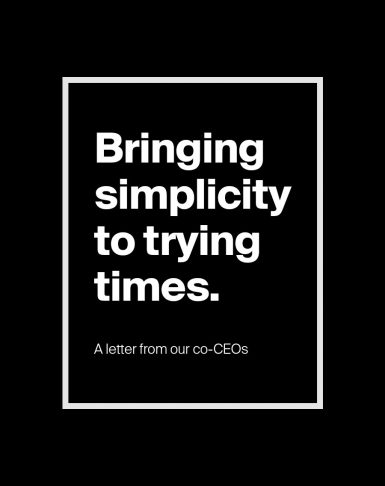In the best of times, it is easy to champion the values of a purpose-led company—to tie wins to being “customer-obsessed” and create intra-company relationships under the philosophy of “acting with integrity.” However, today, brand values—or lack thereof—are being tested under new circumstances.
It is the organization that creates experiences through its brand lens—while simultaneously responding to unforeseen circumstances—that can rebuild its teams and businesses in a post-pandemic world. Across audiences—customers, employees, investors—people are experiencing familiar organizations in a new light and reassessing each brand’s place in their lives. Ultimately, a company’s survival won’t be tied solely to emerging from this era “in the black,” but rather, the experiences it provides during the crisis.
Here are three principles of employee engagement for organizations during these critical times:
1. Be proactive, not reactive about employee engagement
Business does not exist in a vacuum. Organizations need to be a part of the dialogue that is shaping our world and make informed decisions in a new reality.
Let’s look at an illustration.
During the rise of the current global health crisis, Brand A (A), a 4-star restaurant, opted to close before the U.S. government announced mandatory dining restrictions. A cited the brand value “taking care of each other” as a top priority.
In stark contrast, Brand B (B), a competing 4-star restaurant, waited to acknowledge the current climate until a mandatory shutdown was enacted. Only then was internal communication extended, leaving employees in the dark as to their future.
Strong brands internalize situations to relate to the bigger picture in an authentic and ownable way. Without this practice, there is no connection between brand and outcomes. The result is destabilizing for the business at large.
2. Link your decisions to your values, and continuously highlight
Using your brand as a lens for your decision-making, doubling down on your organization’s values, and demonstrating them at every touchpoint provides a compass for navigating uncharted territory. When an organization connects decisions to principles and communicates effectively, the brand strengthens. Through connection, audiences can find a sense of security in an organization’s practices and establish an informed sense of loyalty.
When it came time for A to further reconcile the business via a workforce reduction, it held a virtual town hall to explain that the decision was made on the brand’s foundation of community and integrity. The owner of A was empathetic, comparing the mass layoffs to a “distasteful medicine” that would ultimately ensure survival.
Conversely, B’s first statement to employees begins:
“To all of our team members, as you all know, we are all navigating uncharted territory with no preexisting roadmap or compass except for how we do business.”
The impersonal message then announced the layoff of all hourly employees. The mass email is five lines of copy in total with no reference to how decisions were made, where resources can be found or what the future holds for those who wish to return. A lack of empathy and clarity further destabilized a struggling employee base, leaving people with questions.
3. Be present, check in and follow up
During a season of unforeseen circumstances, many of us are searching for answers. Mediating fear of the unknown is a service that well-designed brands provide. Through engaging audiences in the conversation and providing resources that respond to questions, an organization can establish itself as responsive to concerns.
This principle of employee engagement can be enacted in a multitude of ways. Since the virtual town hall, A hosted live Q&A sessions and established an employee relief fund, refusing to leave its people in the dark. In its communication, A emphasized two main priorities: “taking care of each other” and “ensuring open lines of communication.” By organizing in this manner, A has provided explicit, transparent and relevant updates on the business, city and virus.
At the other end, B distributed a cold follow-up email containing only conflicting instructions for how to retrieve final paychecks.
B not only missed the opportunity to alleviate fear but also furthered uncertainty.
Why the difference matters
A and B shared part-time talent. Upon the restaurants’ re-openings, the odds that the distribution of talent will return to its pre-pandemic state are slim. Employees will no doubt extricate B from their lives, and those who can flock to A will do so with a sense of devotion.
Brand is a compass for familiar territories and uncharted waters. Doubling down on brand values during challenging times delivers organizational direction when it matters most. The teams that will be able to accomplish this throughout this global health crisis will emerge more robust. At the same time, those who fail will only continue to falter in the months ahead.



